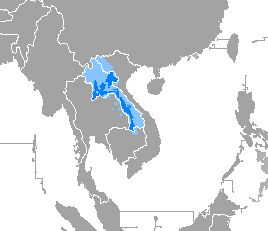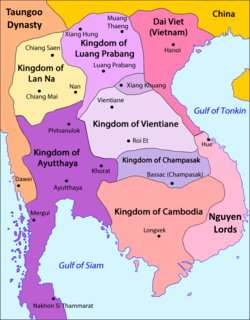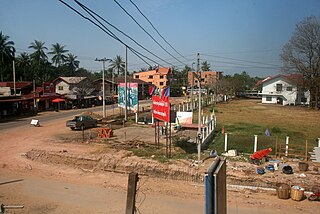Related Research Articles

Laos, officially the Lao People's Democratic Republic, is a socialist state and the only landlocked country in Southeast Asia. At the heart of the Indochinese Peninsula, Laos is bordered by Myanmar and China to the northwest, Vietnam to the east, Cambodia to the southeast, and Thailand to the west and southwest. Its capital and largest city is Vientiane.
Evidence for modern human presence in the northern and central highlands of Indochina, that constitute the territories of the modern Laotian nation-state dates back to the Lower Paleolithic. These earliest human migrants are Australo-Melanesians — associated with the Hoabinhian culture and have populated the highlands and the interior, less accessible regions of Laos and all of South-east Asia to this day. The subsequent Austroasiatic and Austronesian marine migration waves affected landlocked Laos only marginally and direct Chinese and Indian cultural contact had a greater impact on the country.

Lao, sometimes referred to as Laotian, is a Kra–Dai language of the Lao people. It is spoken in Laos, where it is the official language for around 7 million people, as well as in northeast Thailand, where it is used by around 23 million people, usually referred to as Isan. Lao serves as a lingua franca among the citizens of Laos, who also speak approximately 90 other languages, many of which are unrelated to Lao.

The Lao Kingdom of Lan Xang Hom Khao existed as a unified kingdom from 1353 to 1707.

Luang Phabang, or Louangphabang, commonly transliterated into Western languages from the pre-1975 Lao spelling ຫຼວງພຣະບາງ as Luang Prabang, literally meaning "Royal Buddha Image", is a city in north central Laos, consisting of 58 adjacent villages, of which 33 comprise the UNESCO Town Of Luang Prabang World Heritage Site. It was listed in 1995 for unique and "remarkably" well preserved architectural, religious and cultural heritage, a blend of the rural and urban developments over several centuries, including the French colonial influences during the 19th and 20th centuries.
Chao Anouvong, or regnal name Xaiya Setthathirath V, , led the Lao rebellion (1826–28) as the last monarch of the Kingdom of Vientiane. Anouvong succeeded to the throne in 1805 upon the death of his brother, Chao Inthavong, Xaiya Setthathirath IV, who had succeeded their father, Ong Bun or Phrachao Siribounyasan Xaiya Setthathirath III. Anou was known by his father's regal number until recently discovered records disclosed that his father and brother had the same regal name.

Muang Phuan or Xieng Khouang was a historical principality on the Xiangkhoang Plateau, which constitutes the modern territory of Xiangkhouang Province, Laos.

Saraburi is one of the central provinces (changwat) of Thailand. Neighboring provinces are Lopburi, Nakhon Ratchasima, Nakhon Nayok, Pathum Thani, and Ayutthaya. It is believed to have been constructed in the year 1548 during the reign of King Maha Chakkraphat of Ayutthaya as a centre for recruiting troops.

Laos, officially the Lao People's Democratic Republic, is divided into 17 provinces and one prefecture, the Vientiane capital city municipality. The special administrative zone, Xaisomboun, created in 1994, was dissolved on 13 January 2006. In 2013, parts of the former special administrative zone was reestablished as Xaisomboun province.

Pha That Luang is a gold-covered large Buddhist stupa in the centre of the city of Vientiane, Laos. Since its initial establishment, suggested to be in the 3rd century AD, the stupa has undergone several reconstructions as recently as the 1930s due to foreign invasions of the area. It is generally regarded as the most important national monument in Laos and a national symbol.

Wat Si Saket is a Buddhist wat in Vientiane, Laos. It is situated on Lan Xang Road, on the corner with Setthathirat Road, to the northwest of Haw Phra Kaew, which formerly held the Emerald Buddha.

Attapeu, also written as Attopu or Attapu, is the capital of Attapeu Province, Laos. Its official name is Muang Samakhi Xay. It is the southernmost of provincial capitals in Laos.

The French protectorate of Laos was a French protectorate in Southeast Asia of what is today Laos between 1893 and 1953—with a brief interregnum as a Japanese puppet state in 1945—which constituted part of French Indochina. It was established over the Siamese vassal, the Kingdom of Luang Phrabang, following the Franco-Siamese War in 1893. It was integrated into French Indochina and in the following years further Siamese vassals, the Principality of Phuan and Kingdom of Champasak, were annexed into it in 1899 and 1904, respectively.

Haw Phra Kaew, also written as Ho Prakeo, Hor Pha Keo and other similar spellings, is a former temple in Vientiane, Laos. It is situated on Setthathirath Road, to the southeast of Wat Si Saket. It was first built in 1565 to house the Emerald Buddha, but has been rebuilt several times. The interior now houses a museum of religious art and a small shop.

Vientiane is the capital and largest city of Laos, on the banks of the Mekong River near the border with Thailand. Vientiane became the capital in 1573, due to fears of a Burmese invasion, but was later looted, then razed to the ground in 1827 by the Siamese (Thai). Vientiane was the administrative capital during French rule and, due to economic growth in recent times, is now the economic center of Laos. The city had a population of 948,477 as of the 2020 Census.

Wat Ong Teu Mahawihan is one of many Buddhist monasteries in the city of Vientiane in Laos. This name is given to the temple due to the large, bronze Phra Ong Teu Buddha image that is in the temple: the largest Buddha in Vientiane. This temple was initially constructed by King Setthathirath I in the 16th century when Laos was being bombarded by the Burmese, but was later demolished during a foreign invasion. Thus, it may have gone through many reconstructions during the 19th or 20th century to attain the appearance it has today.

Vientiane province is a province of Laos in the country's northwest. As of 2015 the province had a population of 419,090. Vientiane province covers an area of 15,927 square kilometres (6,149 sq mi) composed of 11 districts. The principal towns are Vang Vieng and Muang Phôn-Hông.

Vientiane is a prefecture of Laos, in the northwest Laos. The national capital, Vientiane, is in the prefecture. The prefecture was created in 1989, when it was split off from Vientiane province.
Chakkaphat Phaen Phaeo (1415–1481) reigned as King of Lan Xang from 1442 to 1480, succeeding the Maha Devi after an interregnum of several years. He was born in 1415 as Prince Vong Buri, the youngest son of King Samsenthai by Queen Nan Keo Yot Fa daughter of King Intharacha of Ayutthaya. When he came of age he was appointed as Governor of Vientiane. He was invited to ascend the throne several times during the succession dispute orchestrated by the Maha Devi, but refused. The Council of Ministers finally persuaded him to become king in 1441, after they had failed to find any other candidate. He still refused to be crowned and avoided the ceremony for many years. Finally bowing to custom in 1456, he was formally coroneted and assumed the reign name and title of Samdach Brhat-Anya Chao Sanaka Chakrapati Raja Phen-Phaeo Bhaya Jayadiya Kabuddha. The regnal name is significant because it translates in Pali to cakkavattin, meaning "Universal Buddhist Monarch." Vong Buri, and the court, were claiming enough political and religious power to unify the kingdom, and warn surrounding kingdoms, despite the upheaval caused by the Maha Devi and interregnum in Lan Xang from 1428-1442.
References
- ↑ Askew, Marc; Long, Colin (7 December 2006). Vientiane: Transformations of a Lao Landscape. Routledge. p. 95. ISBN 9781134323654.
- ↑ "Centuries-Old Temple Uncovered in Laos". History News Network. 26 April 2006. Retrieved 11 November 2020.